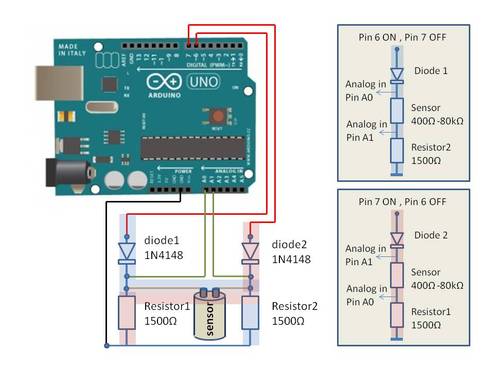Leaf Wetness
-
@AWI your sketch has 3 sensors ? do you use a special wiring or you just get through high and low ?
The sketch on soil humidity does this but with two pins to make kind of AC current, but it needs also some gypsum to protect the electrodes.
. Leaf wetness is not immersed by nature hopefully ;-)
-
@AWI your sketch has 3 sensors ? do you use a special wiring or you just get through high and low ?
The sketch on soil humidity does this but with two pins to make kind of AC current, but it needs also some gypsum to protect the electrodes.
. Leaf wetness is not immersed by nature hopefully ;-)
@epierre It has 3 sensors with copper wiring. It switches the polarity of the voltage divider (1 Mohm in series with the "sensor") and measures the voltage over the sensor. Actualy it is a moisture alarm for a sensitive wooden floor.
and I learned something today :smirk:
"Gypsum is a soft sulfate mineral composed of calcium sulfate dihydrate, with the chemical formula CaSO4·2H2O" -
@AWI You can call it also "Plaster of Paris" ;-)
When immersed you need to protect it whatever you do : http://vanderleevineyard.com/1/category/vinduino/1.html
-
Hello,
I guess it is the same as Vinduino :

with their test code:
// This program tests 3 soil sensor inputs and prints bias caused by galvanic effects // Copyright (C) 2015, Reinier van der Lee // www.vanderleevineyard.com // This program is free software: you can redistribute it and/or modify // it under the terms of the GNU General Public License as published by // the Free Software Foundation, either version 3 of the License, or // any later version. // This program is distributed in the hope that it will be useful, // but WITHOUT ANY WARRANTY; without even the implied warranty of // MERCHANTABILITY or FITNESS FOR A PARTICULAR PURPOSE. See the // GNU General Public License for more details. #include <math.h> // Conversion equation from resistance to % // Setting up format for reading 3 soil sensors #define NUM_READS 10 // Number of sensor reads for filtering long buffer[NUM_READS]; int index; typedef struct { // Structure to be used in percentage and resistance values matrix to be filtered (have to be in pairs) int moisture; long resistance; } values; const long knownResistor = 1500; // Constant value of known resistor in Ohms int supplyVoltage; // Measured supply voltage int sensorVoltage; // Measured sensor voltage values valueOf[NUM_READS]; // Calculated moisture percentages and resistances to be sorted and filtered int i; // Simple index variable void setup() { // initialize serial communications at 9600 bps: Serial.begin(115200); // initialize the digital pins as an output. // Pin 6,7 is for sensor 1 pinMode(6, OUTPUT); pinMode(7, OUTPUT); } void loop() { measure(1,6,7,1); Serial.print ("\t"); Serial.println (average()); long read1 = average(); measure(1,7,6,0); Serial.print ("\t"); Serial.println (average()); long read2= average(); long sensor1 = (read1 + read2)/2; Serial.print ("resistance bias =" ); Serial.println (read1-read2); Serial.print ("sensor bias compensated value = "); Serial.println (sensor1); Serial.println (); delay (3000); } void measure (int sensor, int phase_b, int phase_a, int analog_input) { // read sensor, filter, and calculate resistance value // Noise filter: median filter for (i=0; i<NUM_READS; i++) { // Read 1 pair of voltage values digitalWrite(phase_a, HIGH); // set the voltage supply on delayMicroseconds(25); supplyVoltage = analogRead(analog_input); // read the supply voltage delayMicroseconds(25); digitalWrite(phase_a, LOW); // set the voltage supply off delay(1); digitalWrite(phase_b, HIGH); // set the voltage supply on delayMicroseconds(25); sensorVoltage = analogRead(analog_input); // read the sensor voltage delayMicroseconds(25); digitalWrite(phase_b, LOW); // set the voltage supply off // Calculate resistance // the 0.5 add-term is used to round to the nearest integer // Tip: no need to transform 0-1023 voltage value to 0-5 range, due to following fraction long resistance = (knownResistor * (supplyVoltage - sensorVoltage ) / sensorVoltage)-457 ; delay(1); addReading(resistance); Serial.print (resistance); Serial.print ("\t"); } } // Averaging algorithm void addReading(long resistance){ buffer[index] = resistance; index++; if (index >= NUM_READS) index = 0; } long average(){ long sum = 0; for (int i = 0; i < NUM_READS; i++){ sum += buffer[i]; } return (long)(sum / NUM_READS); }and my hall of fame and shame of sensors I've tried :

